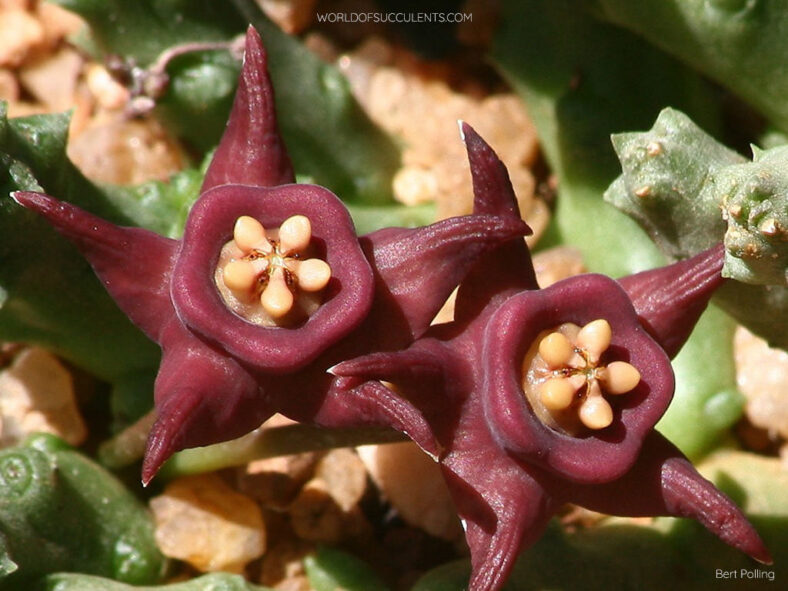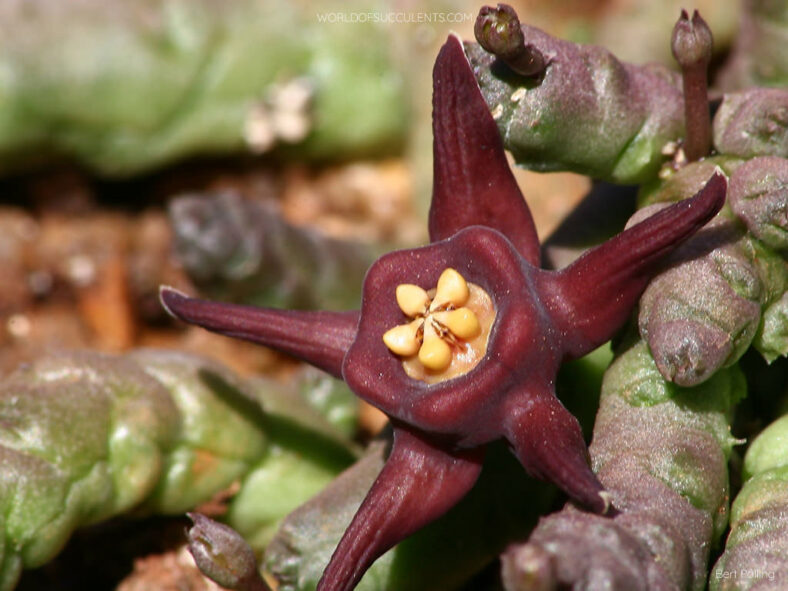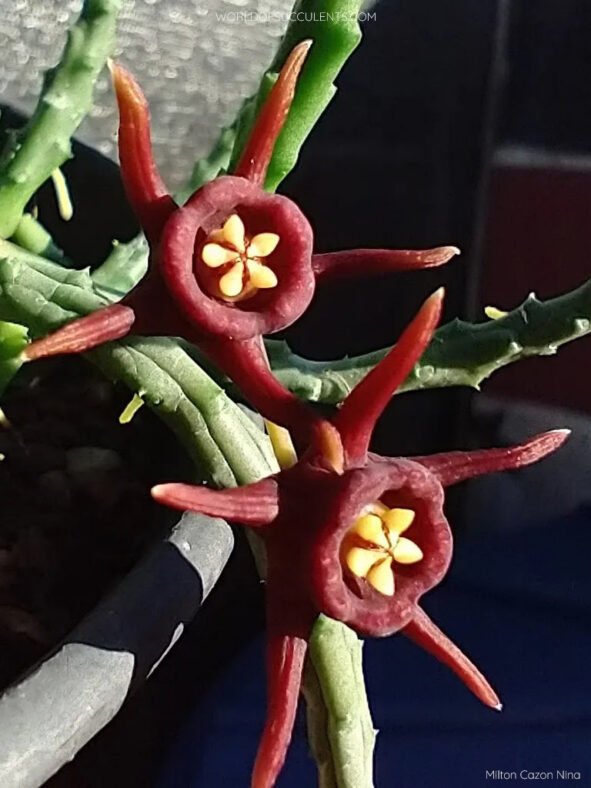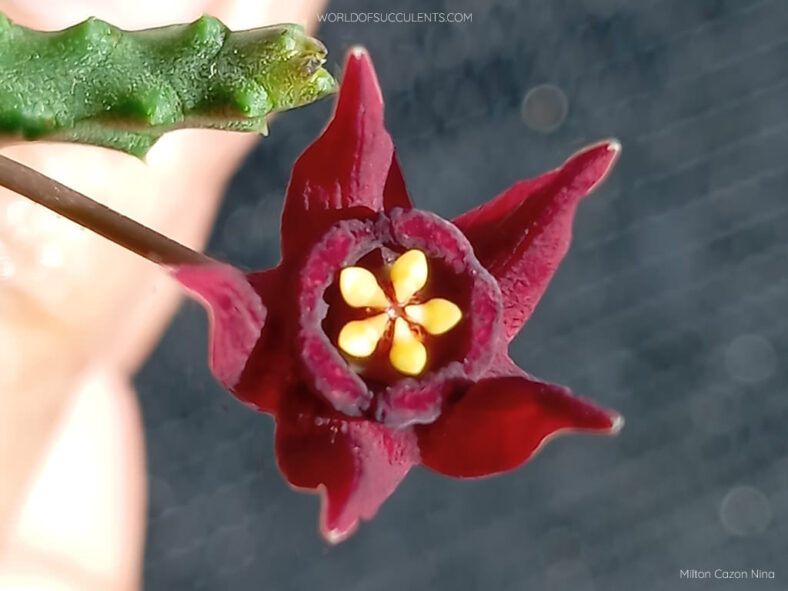Duvalia immaculata was first collected by Deborah Susanna Van Der Bijl. In 1933, Alain Campbell White and Boyd Lincoln Sloane published two photographs of the plant as Duvalia maculata. In 1937, they classified it as a variety of Duvalia maculata. However, in 1977, Martin Bruce Bayer proposed that it should be recognized as a separate species. Finally, in 1989, Larry Leach formally raised it to the status of a distinct species.
Scientific Name
Duvalia immaculata (C.A.Lückh.) Bayer ex L.C.Leach
Synonym(s)
Ceropegia immaculata, Duvalia maculata var. immaculata
Scientific Classification
Family: Apocynaceae
Subfamily: Asclepiadoideae
Tribe: Ceropegieae
Subtribe: Stapeliinae
Genus: Duvalia
Etymology
The specific epithet "immaculata" (pronounced "im-mak-yoo-LAH-tuh") means "unstained" and refers to the unspeckled ring-like structure (annulus) of the flowers of this species, distinguishing it from Duvalia maculata, which has a speckled annulus.
Origin
Duvalia immaculata is native to South Africa. It grows under short bushes in flat, gravelly areas from Swellendam to Mossel Bay in the Western Cape province.
Description
Duvalia immaculata is a dwarf succulent with cylindrical stems that range from green to brown and have conical tubercles arranged into 4 to 5 obscure angles along their length. The decumbent stems can grow up to 2 inches (5 cm) long and 0.5 inches (1.2 cm) wide. The tubercles narrow abruptly into very short, pointed leaf rudiments with microscopic stipular glands.
During the fall, Duvalia immaculata produces inflorescences consisting of 1 to 6 flowers that gradually open, primarily in the lower half of stems. The corolla can reach a diameter of 1.2 inches (3 cm). The outer surface of the corolla is brownish-green, while the interior is dark chocolate-brown and has a dull, velvety texture. The annulus is often pentagonal, covered with fine papillae, and can measure about 0.45 inches (1.1 cm) in diameter. The corona is yellow with a faint brown tinge.

How to Grow and Care for Duvalia immaculata
Light: Duvalia immaculata prefers full sun but will benefit from light shade during the hottest summer days. Indoors, place the plant near the brightest window of your home because it will stretch if it does not receive enough sunlight. Avoid abruptly moving a plant adapted to lower light levels to full sun to prevent sunburn.
Soil: Use commercial potting soil mix for succulents or prepare your own with 50% to 70% mineral grit, such as coarse sand, pumice, or perlite.
Temperature: The plant thrives in warm outdoor environments with low to moderate humidity. It does not like winter cold and should remain fairly dry and warm during its dormancy. Duvalia immaculata is hardy in USDA Plant Hardiness Zones 11a-11b, which have average annual extreme minimum winter temperatures ranging from 40°F to 50°F (4.4°C to 10°C).
Watering: It has typical watering needs for a succulent. During the growing season, from spring to fall, water the plant thoroughly and allow the soil to dry between waterings. When it goes dormant in winter, it needs almost no water, about once a month.
Fertilizing: Fertilizing is a good idea to keep the plant healthy and thriving. Feed it with water-soluble fertilizer diluted to half the recommended strength, but only when the plant is actively growing.
Repotting: Repot Duvalia immaculata in spring, just before the growing season. It has shallow roots and does not require too much soil to grow. Always pick a container with drainage holes.
Propagation: The best way to propagate this succulent is by stem cuttings. To ensure good rooting, take cuttings during the growing season. The plant is also easy to start from seeds in spring.
Learn more at How to Grow and Care for Stapeliads.
Toxicity of Duvalia immaculata
Duvalia immaculata has no toxic effects reported, so it is safe for growing around kids and pets.
Links
- Back to genus Duvalia
- Succupedia: Browse succulents by Scientific Name, Common Name, Genus, Family, USDA Hardiness Zone, Origin, or cacti by Genus
Photo Gallery
Click on a photo to see a larger version.


